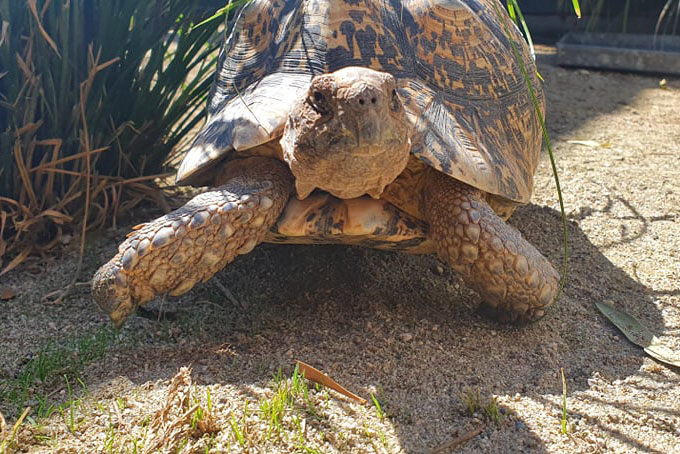Leopard Tortoise
Stigmochelys pardalis

Distribution:
Southern and Eastern Africa - Sudan to Ethiopia
Habitat:
Dry and arid regions like savannas, thorn-scrub, mesic brushland
Diet:
Grasses, thistles, succulents, as well as bones and hyena droppings
Gestation:
Incubation period of 8-15 months
Longevity:
Up to 75 years
Predators:
Eggs and hatchlings are eaten by snakes, lizards, jackals and crows.
Conservation Status:
Least concern
General:
The fourth largest tortoise species in the world can be found roaming the savannas of eastern and southern Africa, where it grazes for grasses, succulents and thistles.
As well as eating plant matter, leopard tortoises eat hyena droppings (a behaviour called coprophagia) and chew on animal bones (called osteophagia). Both droppings and bones have high levels of minerals that help the tortoise keep its shell strong and healthy, as well as helping in producing their eggshells. Leopard tortoises are crepuscular, being active mostly around dawn and dusk.
The panels on a tortoise shell are called scutes. Scutes grow with seasons and the ridges on them can be counted to gauge the animals age – much like counting the rings on a tree! This can be made difficult due to wear on an older animal’s shells. Leopard tortoises lack a protective scute around its neck (called the nuchal shield), making the leopard tortoise the only species of tortoise that can swim thanks to being able to raise its head!
Leopard tortoises are able to store water in a specialised organ called the bursa sac during dry periods. As well as using it to stay hydrated, females use it to moisten hard and dry ground so they can dig burrows in which to lay eggs.
At Hamilton Zoo:
We have four leopard tortoises at the zoo. They live in the Parrot Court. You may have to look closely to spot them!
Males:
Pinky
Blinky
Inky
Clyde
